Tsukuba Uchu Forum
115th Uchu Forum
Supermassive black hole seed formation in the early universe
Yuya Sakurai
IPMU
Abstract
Recent three-dimensional cosmological simulations of protogalaxy formation have suggested that supermassive stars (SMSs) can form in warm gas clouds in which H2–cooling is overwhelmed by dynamical heating (Wise et al. 2019), but they stopped short of following the growth of a central protostar. Here we we examine whether accretion on the protostellar core in this cloud is sufficiently rapid, in the face of the radiation feedback, to produce an SMS. We perform one-dimensional radiation-hydrodynamical simulations of the hot collapsing cloud with non-equilibrium chemical reactions directly adopting the cloud properties from Wise et al. (2019) as an initial condition. We find that the stellar Lyman-Werner (LW) radiation dissociates H2 in the inner regions of the gas flow, increasing gas temperature and thermal pressure, and temporarily stopping the accretion. However, this negative feedback ceases when the self-gravity and inward ram pressure force on larger scales push the gas inward. The central protostar is unable to create an HII region due to the high density, and grows to a mass of >10^5 Msun. Our results suggests the successful formation of SMSs, and resulting massive (~10^5 Msun) remnant black holes, in dynamically heated haloes, but need to be confirmed in two- or three-dimensional simulations.



 和 英
和 英